[Atari, SUPERware]
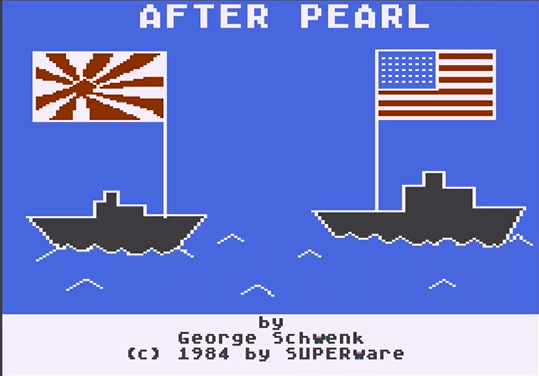
After Pearl is an ambitious game by SuperWARE, modelling a streamlined version of the Pacific War – all of it – in less than two hours. The main campaign begins shortly after the battle of Pearl Harbor, as the Japanese are trying to expand their dominion in the South and in the East.
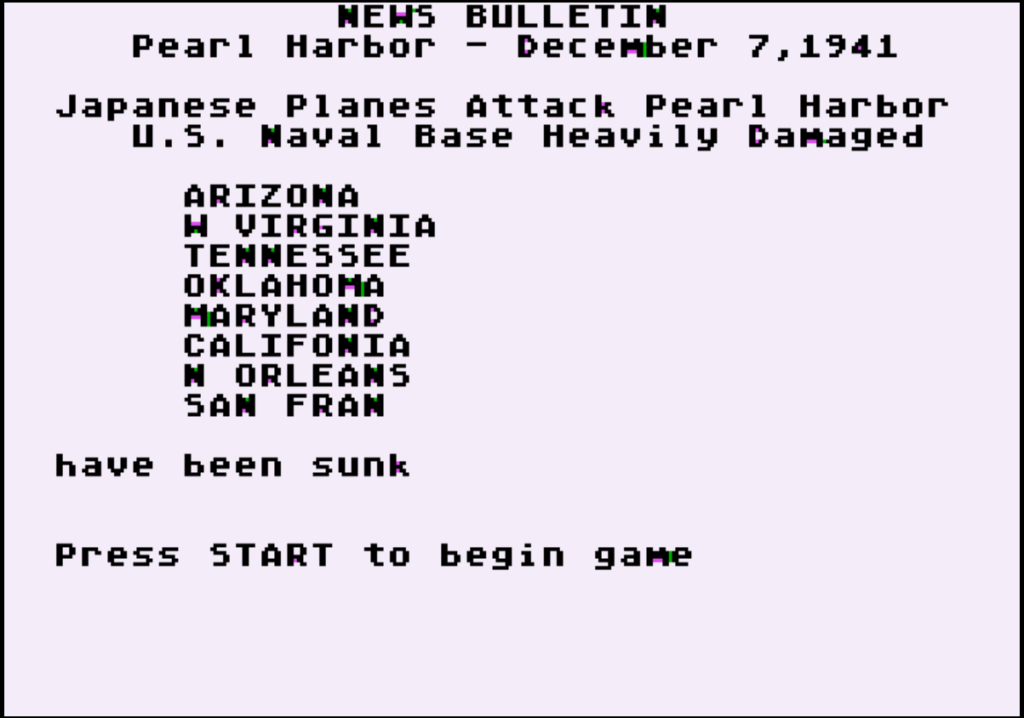
The objective is to finish the game (after 40 turns) with more points than the Japanese, points being earned every turn by holding naval bases (sinking ships does not give any points). The Japanese start with more aircraft carriers and more bases, ensuring a steady flow of points early in the game. While the American player will receive a lot more reinforcements, these only arrive during the middle of the game, so the player must try to deny the Japanese as many points as possible in the early turns.
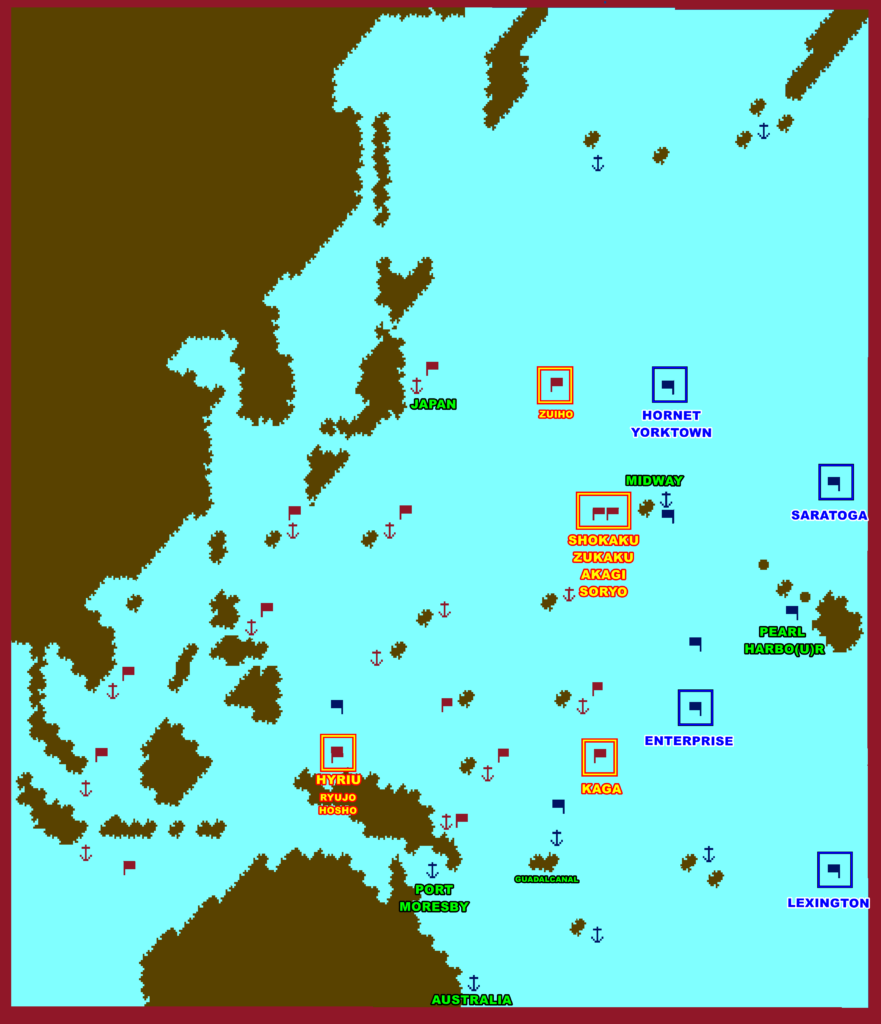
The “Battle” of Midway (turns 1-3)
The game opens with two difficult situations:
- In the East, the Japanese are around Midway with a concentrated force of 4 fleet carriers. All I have in Midway is an airport and two cruisers. I have 4 fleet carriers within range, but they are spread out all over the place.
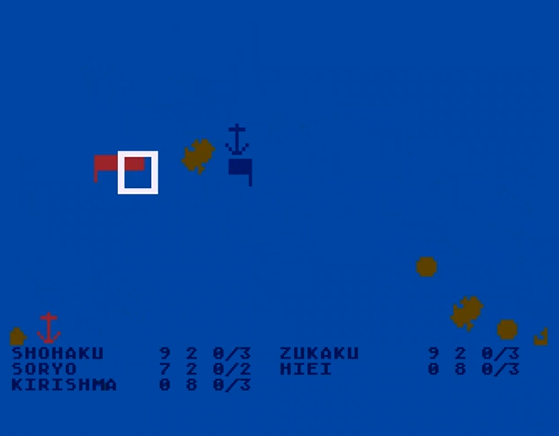
- In the South, the Japanese will probably try to occupy Port Moresby. They have one fleet carrier and two light carriers ready to support, while my only carrier able to come to support Port Moresby, the USS Enterprise, is currently facing a second Japanese fleet carrier.
I feel that challenging the Japanese in Midway could spell my doom: my carriers could be defeated in detail, and trading one carrier for one carrier would increase the gap with the Japanese in the pivotal early turns. Instead, I decide to ignore Midway and concentrate in the South: I believe that the USS Enterprise, the USS Lexington and later the USS Saratoga can challenge the Japanese in the South and defend Port Moresby. Meanwhile, the USS Hornet and the USS Yorktown will attack the isolated escort carrier Zuiho before it can merge with the rest of the Japanese Midway force.
Well, that’s the plan, but the turn resolution does not follow this at all. In After Pearl, air attacks are automatic. Planes on airfields or carriers attack whoever is in range during each of the six impulses of turn resolution, and they always prioritize aircraft carriers over other ships.
The planes on Midway attack the Japanese fleet, and against all odds they cripple the Shokaku and sink the Akagi.
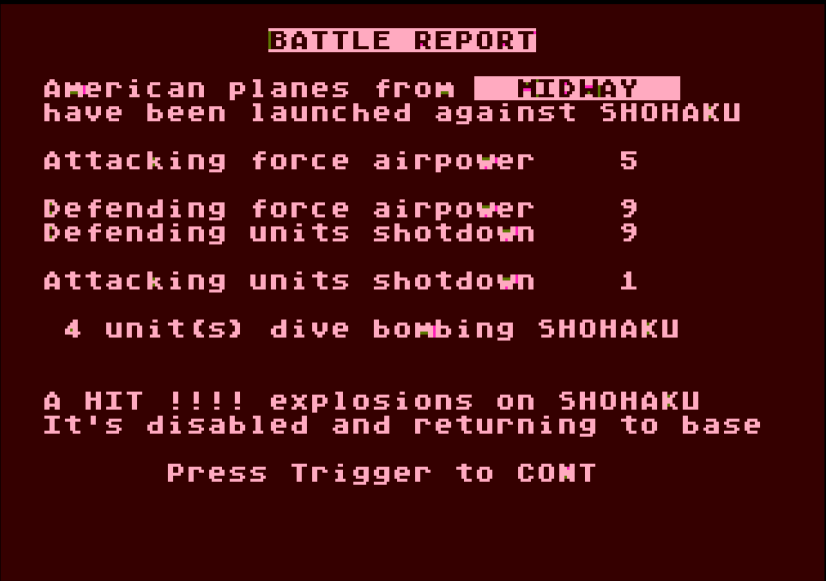
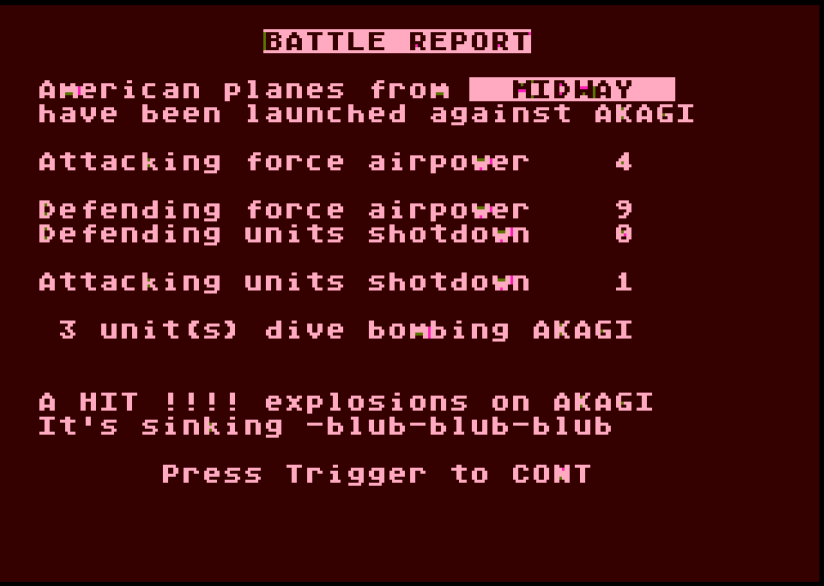
Ships “returning” to base are immediately removed from the map while they are repaired, so that’s 2 fewer Japanese Fleet Carriers to worry about without any active action on my part.
Shortly after this first engagement, I catch the light carrier Zuiho as planned and destroy it:
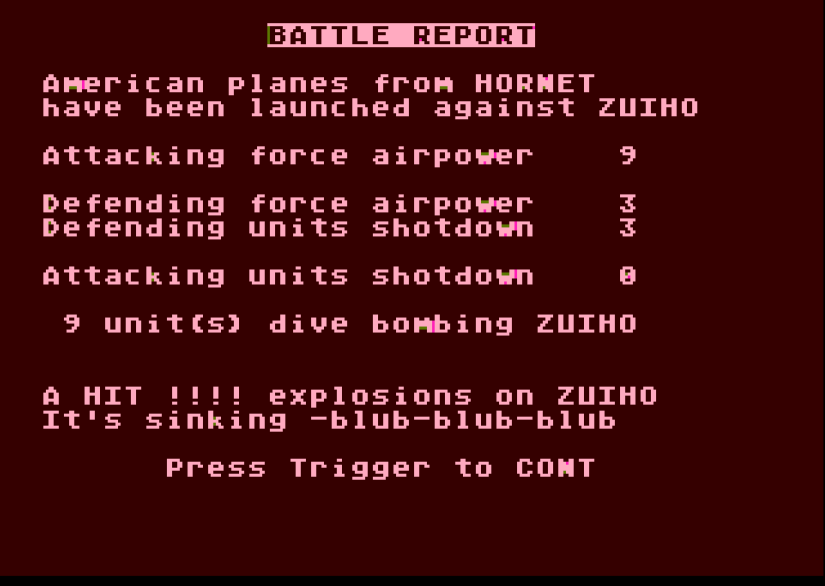
… but what do you know… the Zuikaku and the Soryo were themselves trying to catch my carrier fleet. My planes strike first and I sink them both!
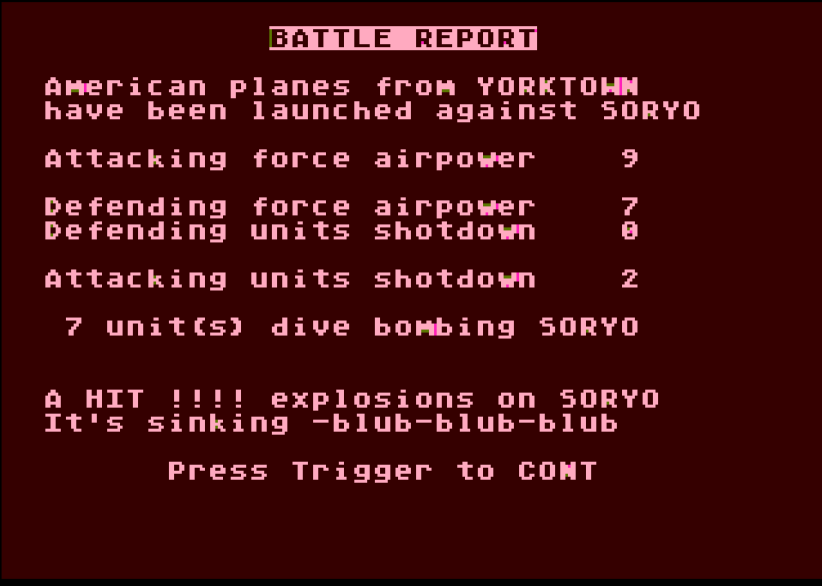
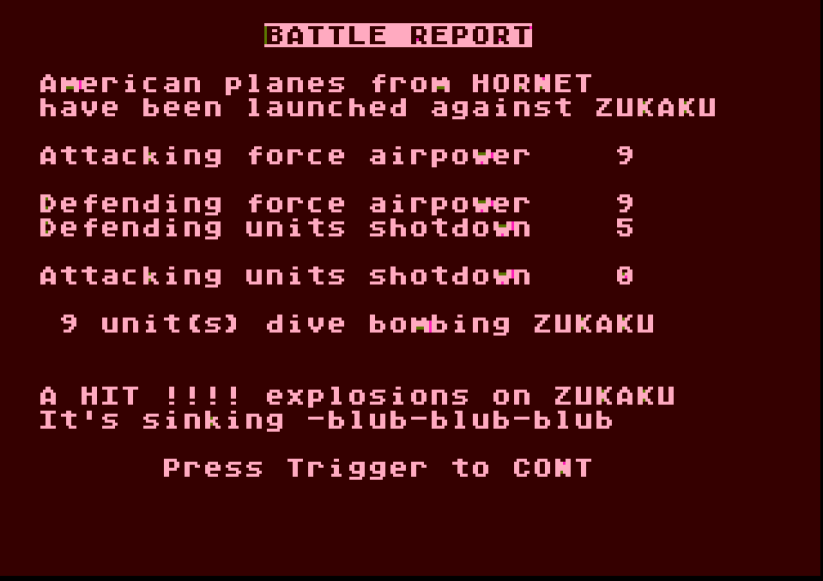
And just like that, turn 1, the Japanese have lost 5 aircraft carriers, four of them forever.
But the turn resolution is not over, and this happens:
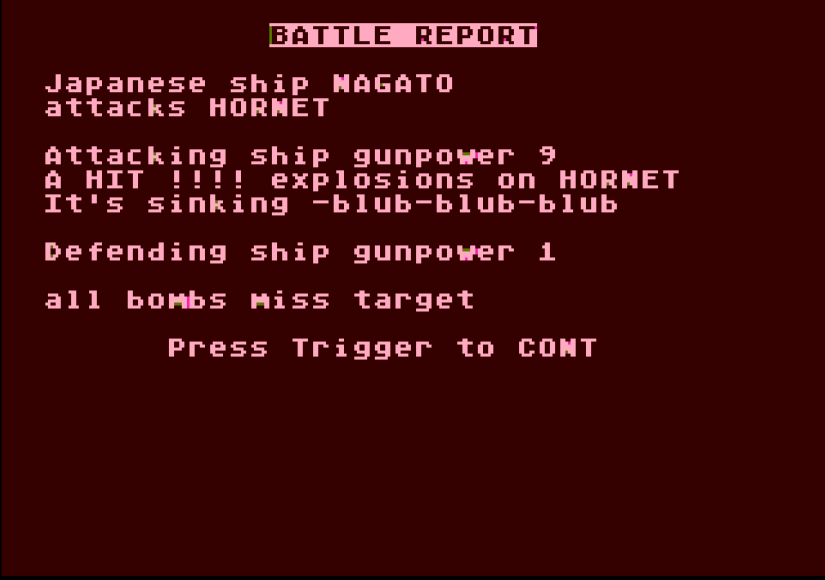
The Japanese surface fleet happened to move exactly where I had sent my carrier fleet and it destroys the USS Hornet and the USS Yorktown the old-fashioned way: with guns and rangefinders.
That’s the end of turn resolution, and the game counts the points accumulated thus far:
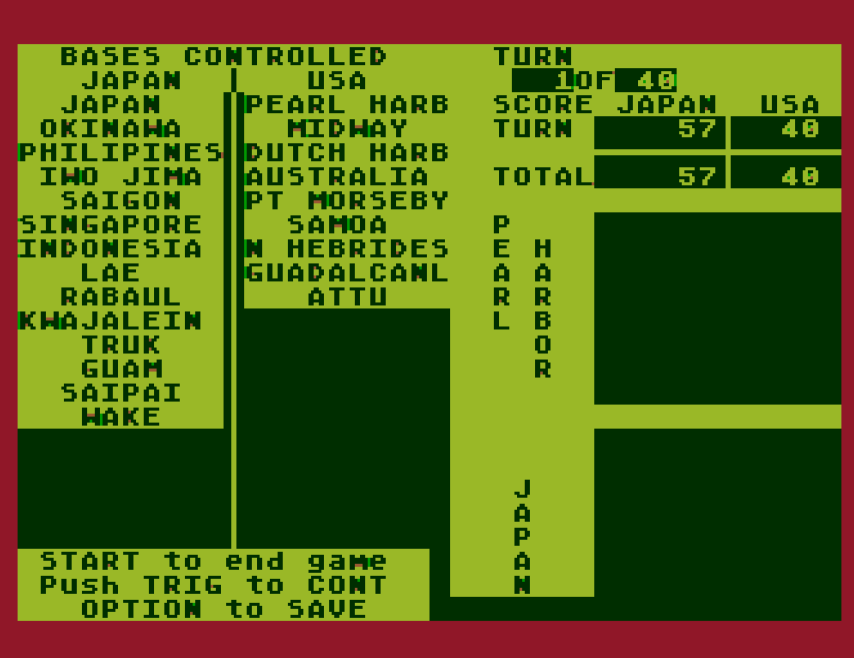
Neither side received reinforcements, so I have 3 Fleet Carriers left against 2 Fleet Carriers and 2 Light Carriers. I like those odds better.
Midway is still under attack by cruisers and battleships. If these “siege” the port for 3 consecutive turns, Japan will take control of the island. All the planes on the Midway airbase have been destroyed and will not come back in the foreseeable future, but the USS Saratoga is still around: by chance her movement was blocked by an islet near Pearl Harbor, so I can easily reroute her.
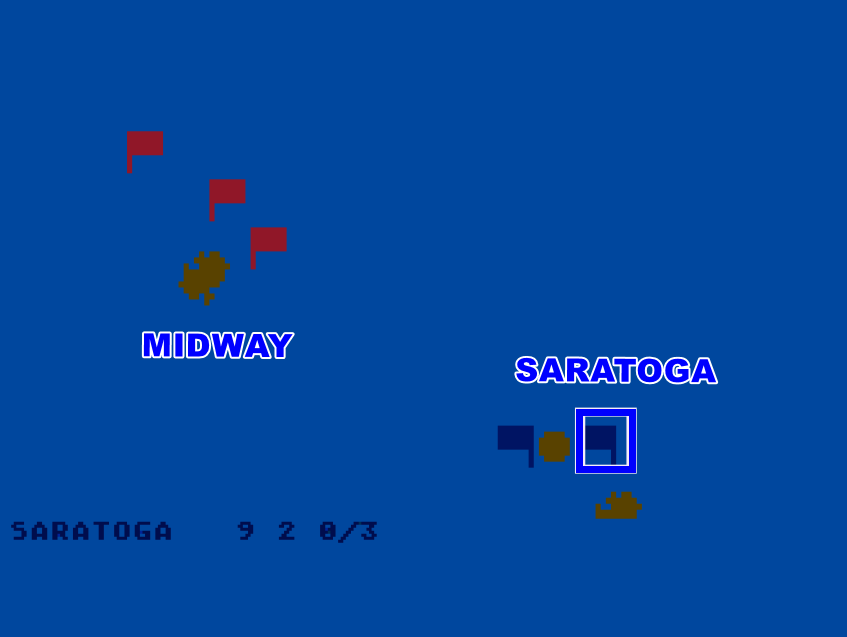
Alas, it will take one more turn for the USS Saratoga to go around that island. When it finally arrives in front of Midway, it is too late. The USS Saratoga inflicts massive damage (it can attack 6 times every turn, and planes are immune to AA fire from surface ships) but Midway is still captured at the beginning of turn 4.
Meanwhile, more in the South, the Kaga has lost all its planes fighting those of Guadalcanal. Aircraft carriers only recover one plane by turn, so the USS Enterprise and the USS Lexington pounce at her.
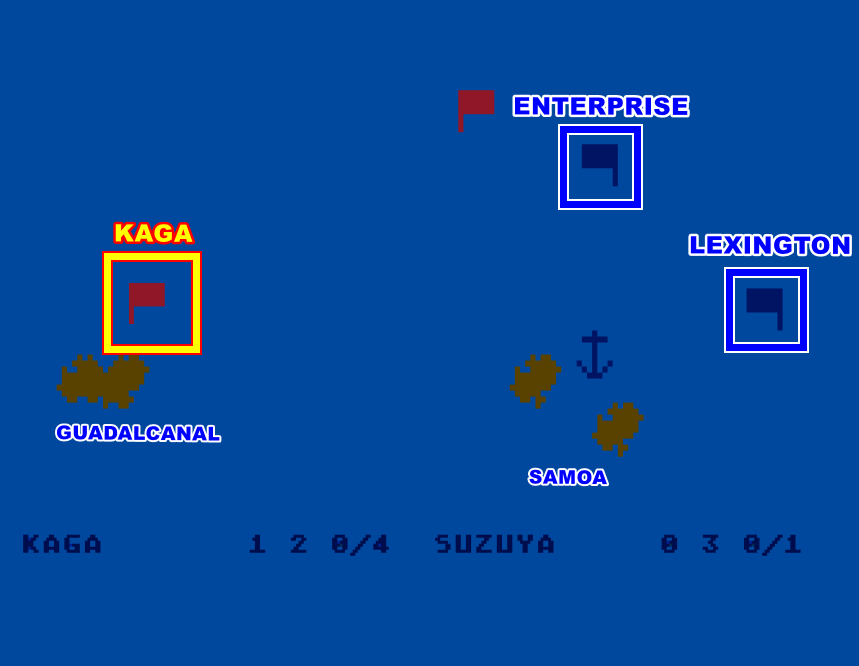
The Kaga is initially extremely lucky, fending off several attacks from the USS Enterprise:
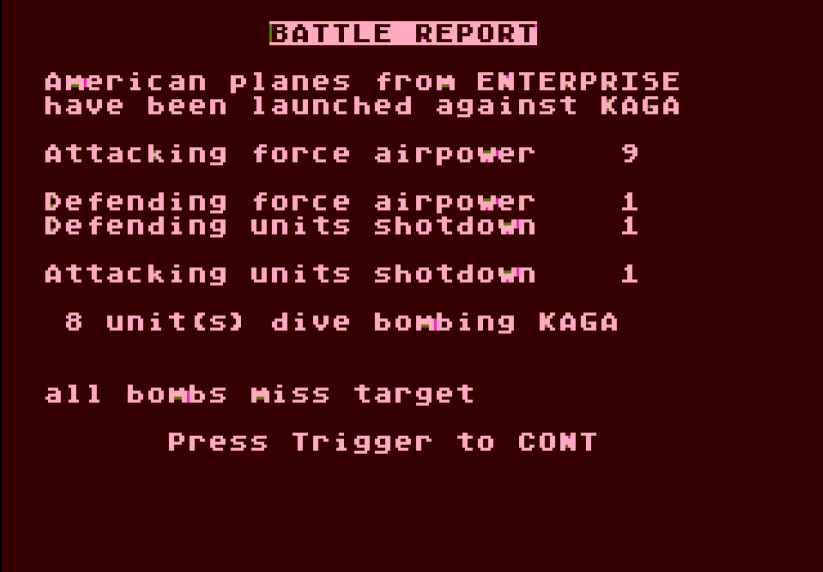
But eventually, she is sunk at the beginning of turn 4.
The campaign of Australia (turns 4-7)
I have won the battle of Midway – more thanks to luck and the ineptitude of the Japanese than to my skill. But the Japanese still lead in points and have received two new carriers – we are back at parity.
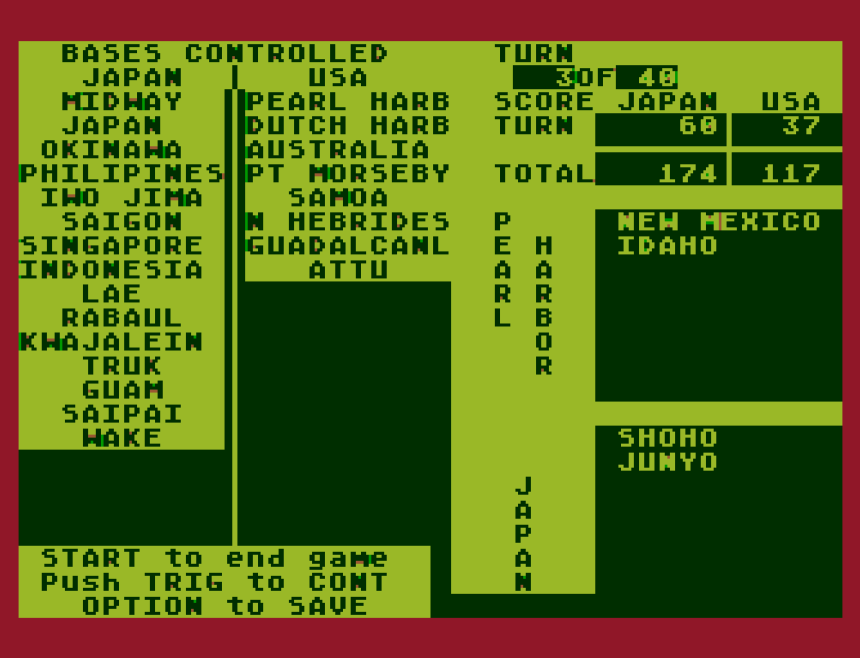
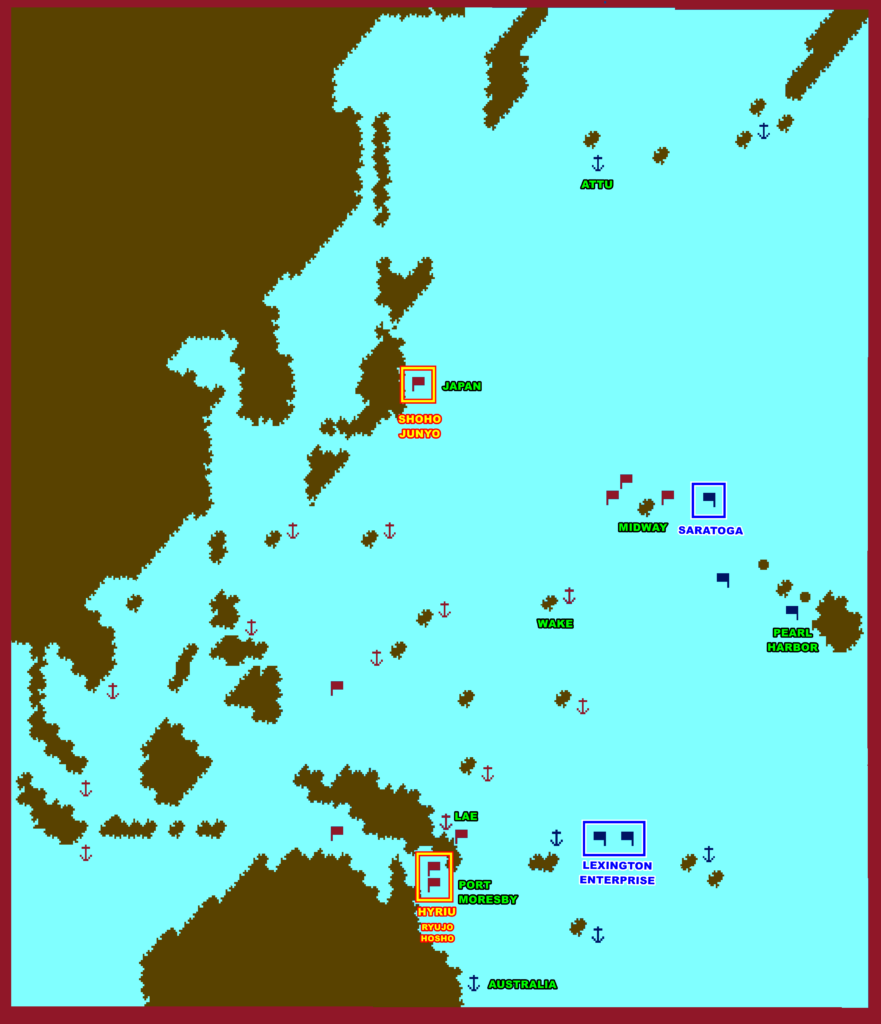
The coming turns are going to be about two things:
- First, Port Moresby and Australia. The US planes at Port Moresby were all shot down without destroying any Japanese carrier, so my two fleet carriers are facing three smaller ones. I feel I should win, but I cannot be sure – the game is too random – and if I lose my two carriers then I will have nothing to slow down the Japanese in the South Pacific.
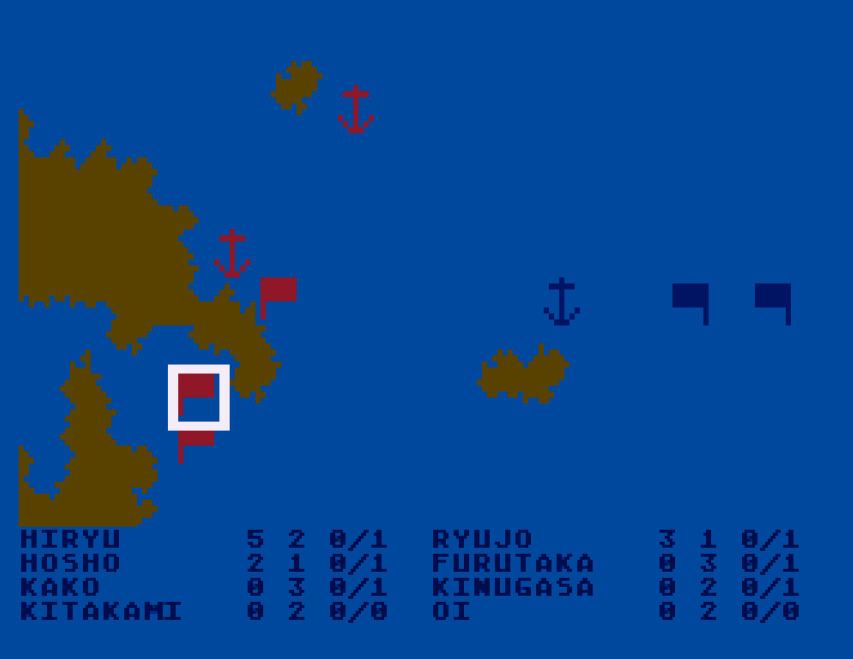
I therefore opt for a defensive move: I will let the Japanese take Port Moresby, but I will defend Australia (or Guadalcanal, if that’s their next target). The support from the land base could make the difference.
- In Midway, I don’t have much time to retake the island before the two new carriers weigh in so I decide to aggressively use my new battleships to destroy the Japanese. Hopefully, I can control the island for 3 turns to recapture it before the Japanese reinforcements arrive.
I execute my plan. In the South, the Japanese fleet captures Port Moresby unopposed, and then heads for Australia where I had moved my carrier fleet. Their 3 carriers have 12 planes in total whereas mine have 18, supported by 8 extra planes from Australia. Predictably, all the Japanese carriers are sunk, and then their escorts, but I lose the USS Enterprise:
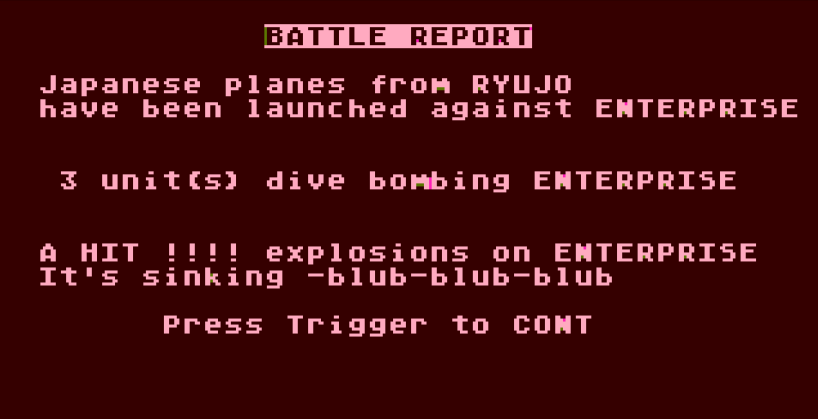
Near Midway, my zerg attack works wonderfully.
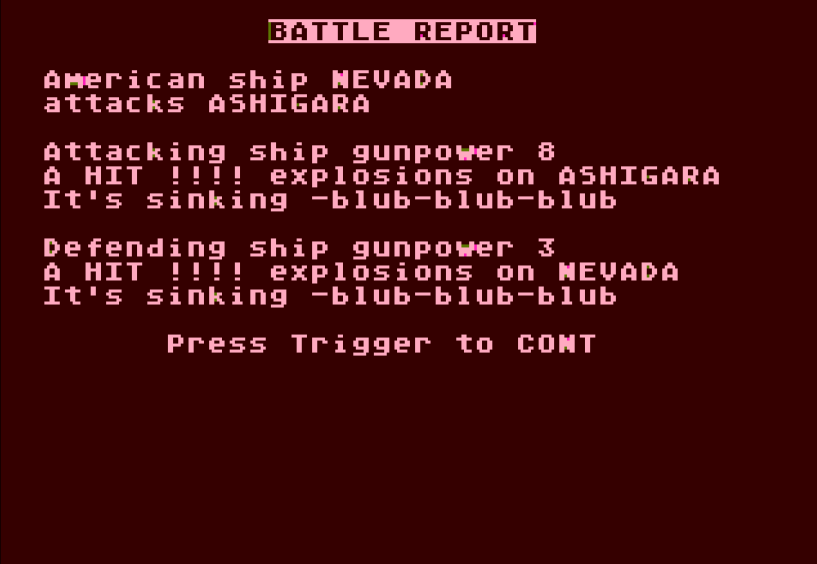
Midway is liberated, and I am moving South toward Wake Island, destroying its plane garrison at the cost of all the planes of the USS Saratoga. but the Japanese carriers never came. Instead, they tried to capture the Aleutian Islands and were both sunk by land-based bombers they outnumbered 12:5. This is a ridiculous course of events.
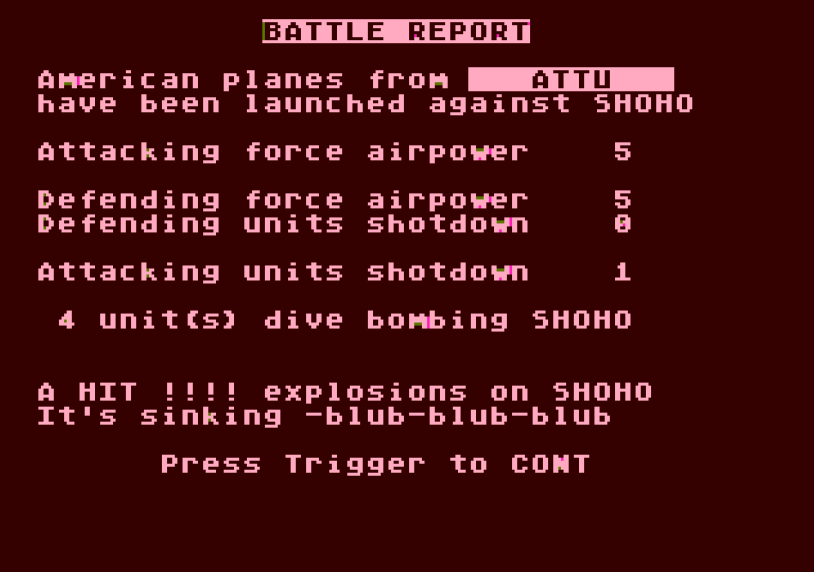
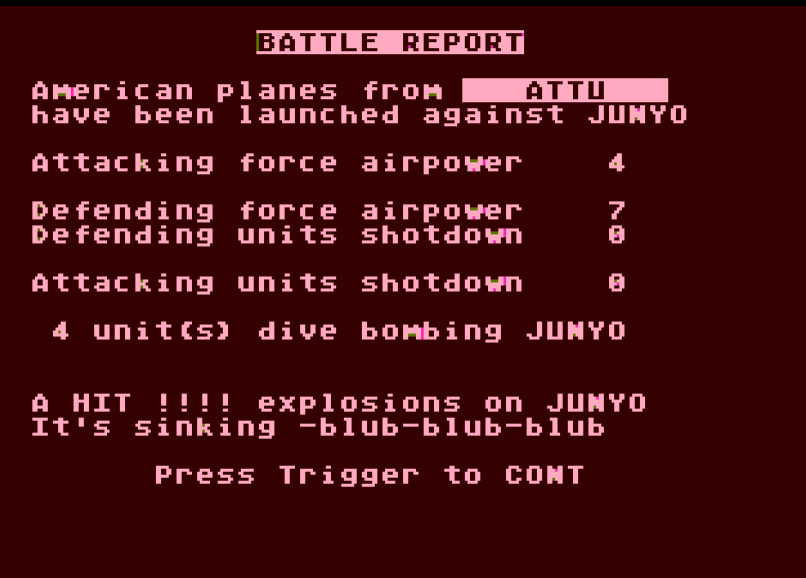
Meanwhile, the Japanese have received the Hijo, another carrier, escorted by the Yamato. They head toward Wake Island, where the USS Saratoga is out of planes. Can they turn the tide?
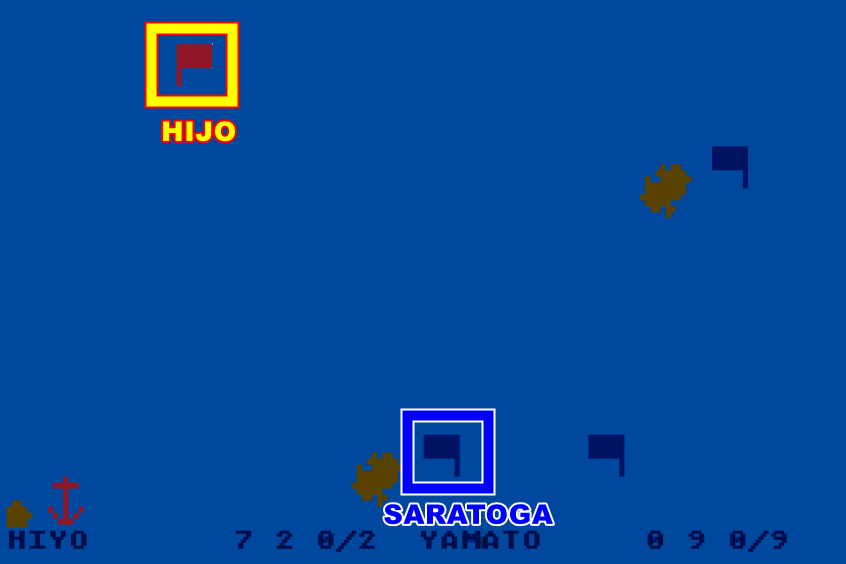
The end of the Hijo and the Yamato (turn 8)
No.
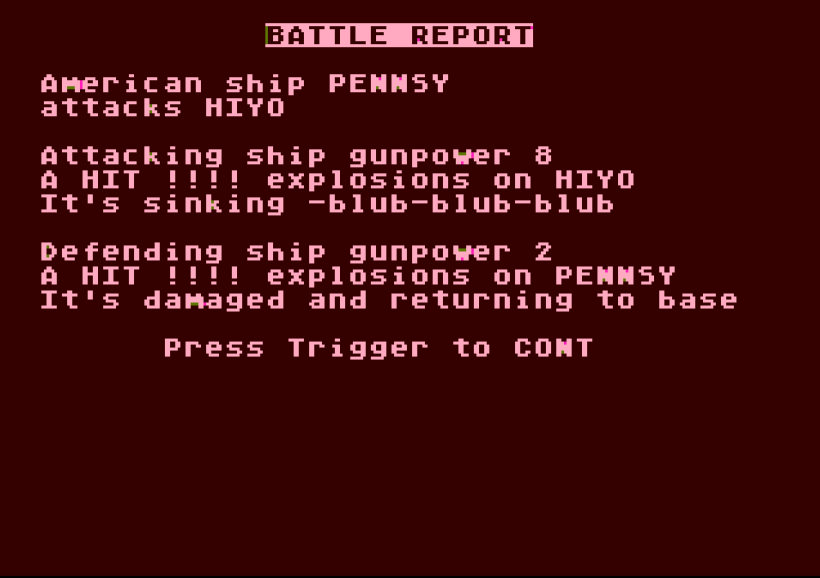
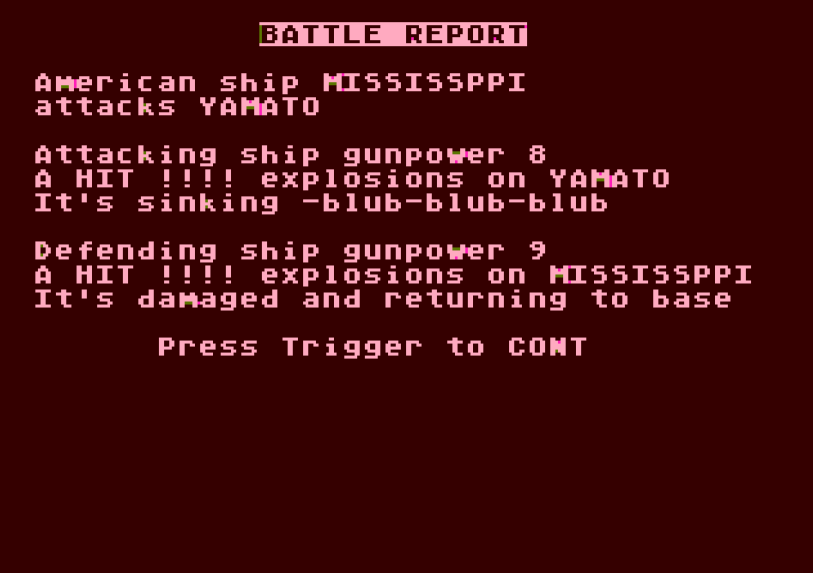
The rest of the game (turns 9-40)
Well, that’s it:
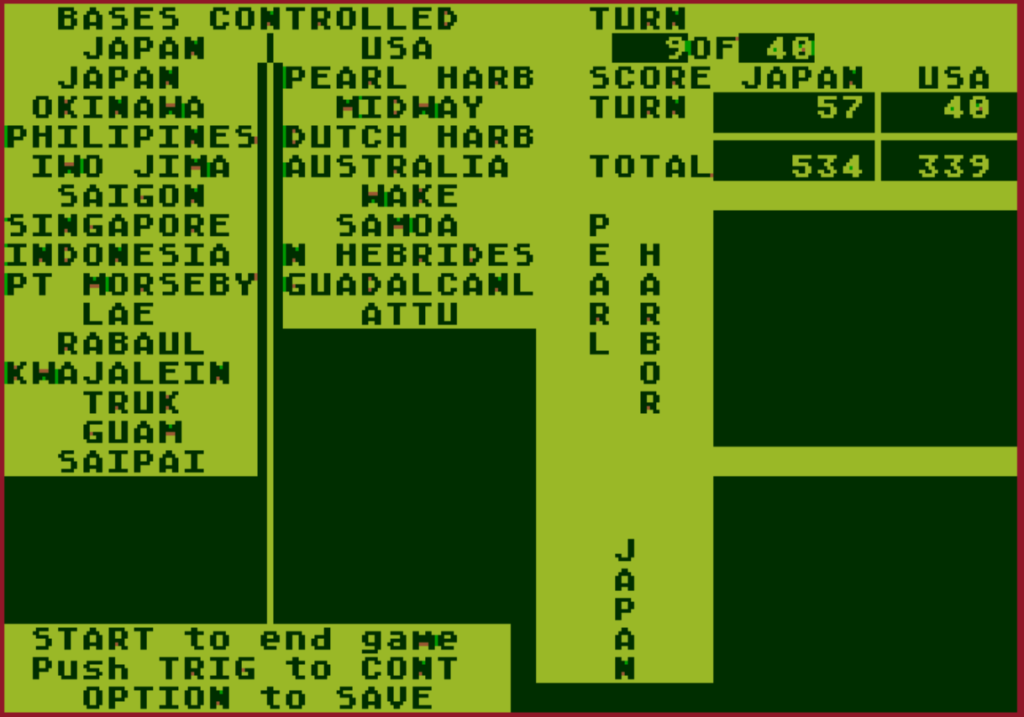
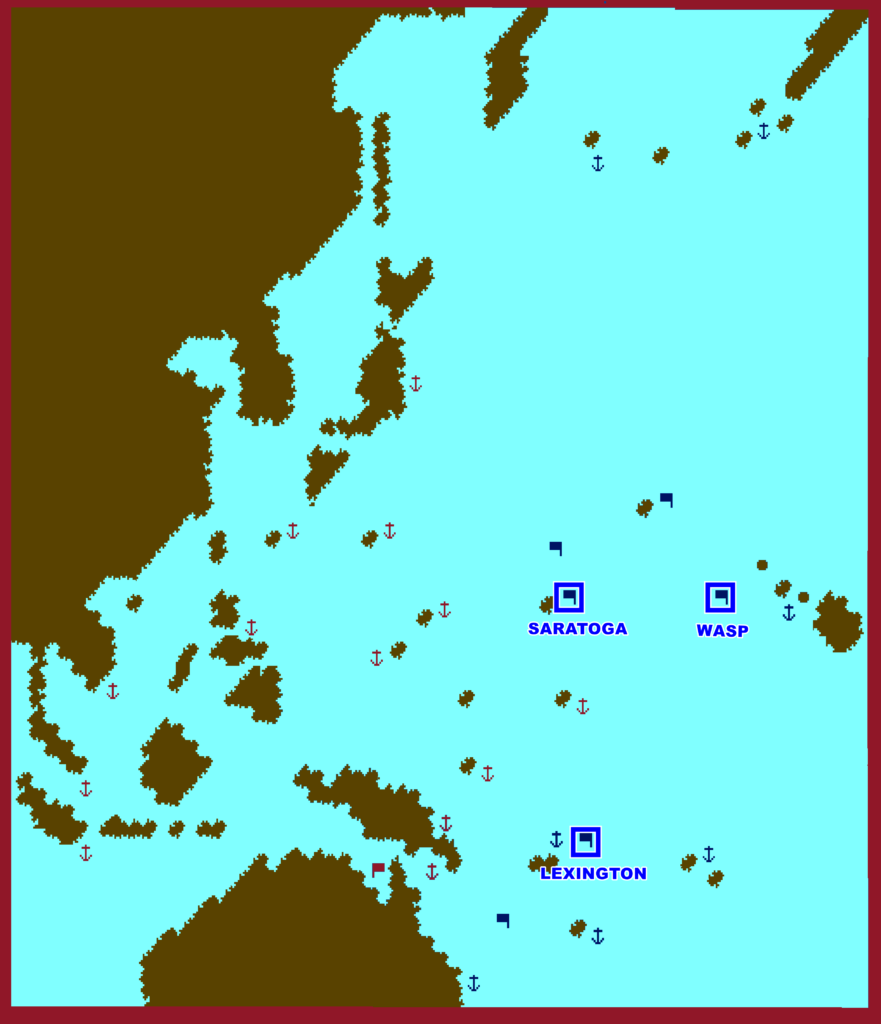
I am behind in points, but there are no more Japanese ships (except one cruiser blocked by the terrain North of Australia). I have 3 carriers and will receive more ships every other turn. This is just a question of waiting to have enough planes on my carriers, approaching an enemy base to destroy its planes, and siege it. Rinse & repeat.
I won’t expand on the details. Suffice to say that I lose the USS Saratoga and later the USS Wasp in these approaches, but not before grabbing enough islands to take the advantage in terms of points earned:
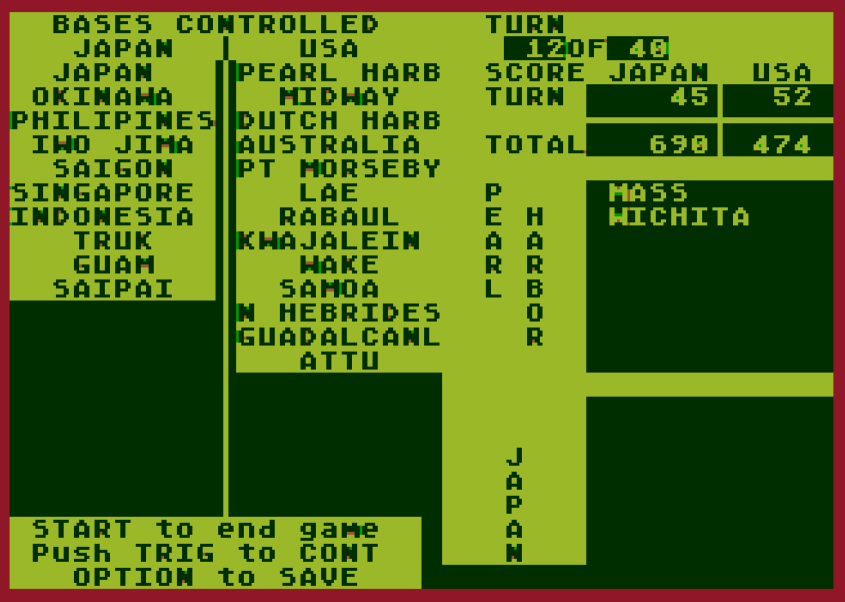
A few turns after losing my carriers, the Japanese receive a repaired Shokaku. This happens two turns later:
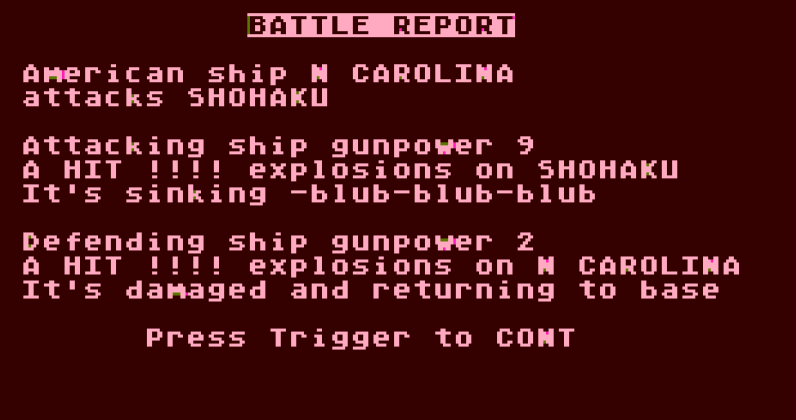
Around turn 20, the Japanese receive their final batch of reinforcements (1 fleet carrier, 3 escort carriers and 2 cruisers) but those ships never left Japan. Meanwhile, I also receive new carriers: the USS Essex, the USS Monterey, the USS Independence, the USS Belleau Wood, the USS Princeton and the USS Cowpens.
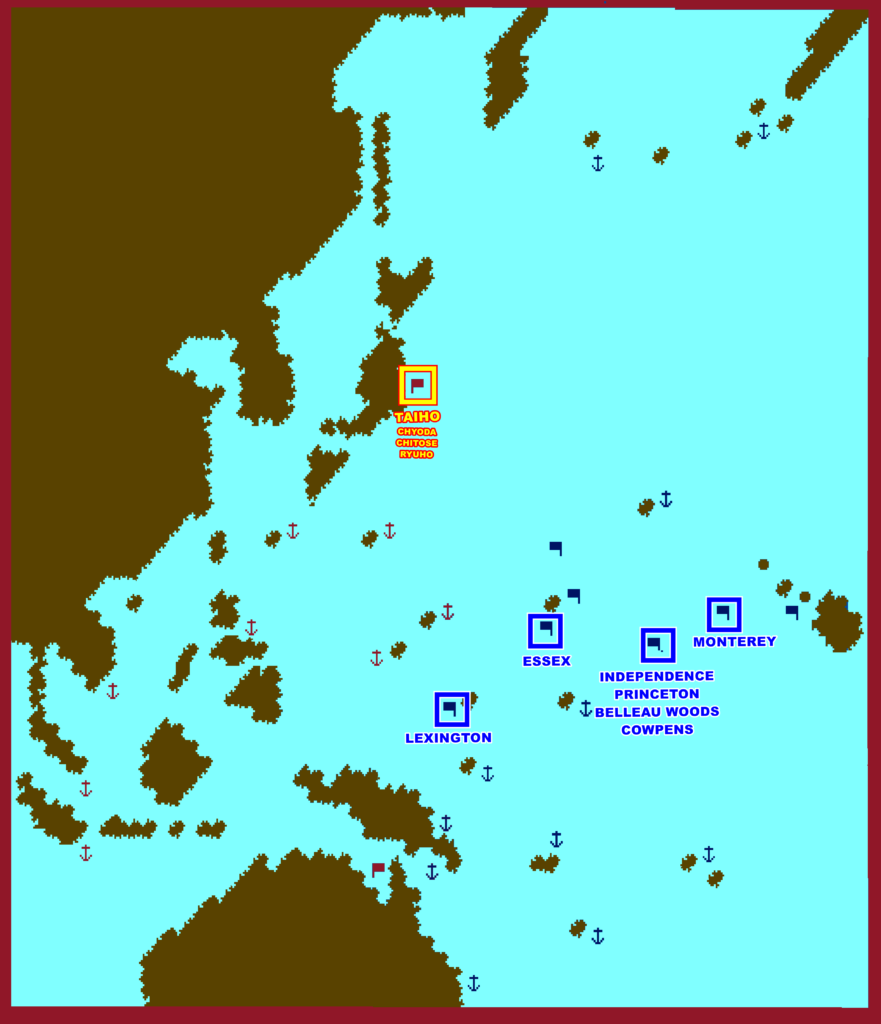
I allocate the Lexington and the Essex to the liberation of Southeast Asia while the rest of my fleet prepares to overrun Japan!
Before attacking with my carriers, I ask each of them to look at the carrier on their port and then to look at the carrier on their starboard: “Two turns from now, only one of you will be on the correct side of the surface“. The Japanese have a LOT of planes in Japan.
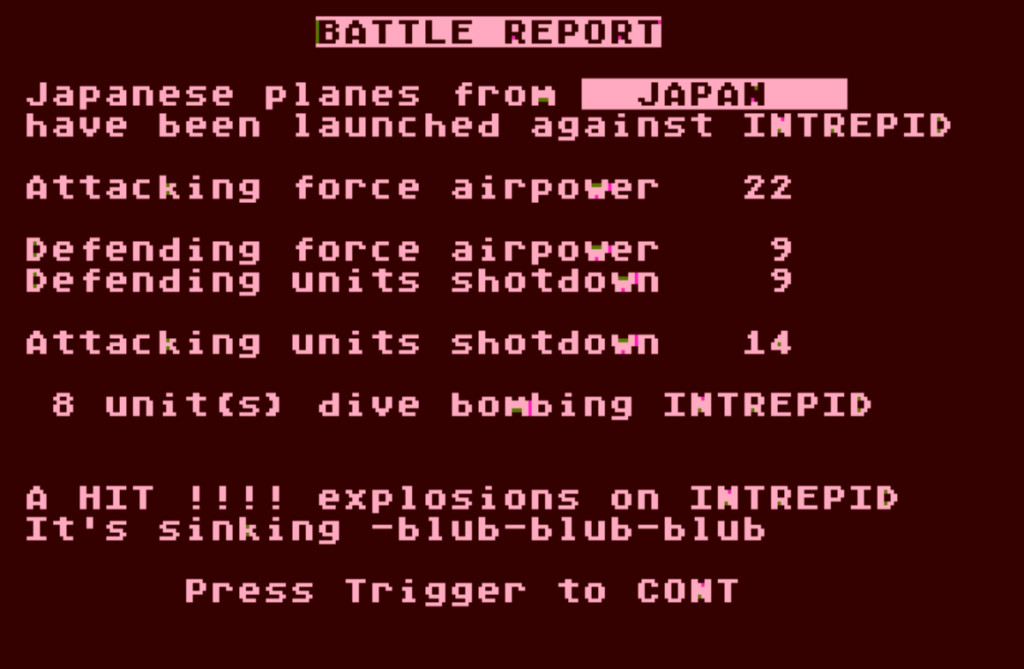
But eventually, I prevail. I lose 6 of my carriers, but I sink all the Japanese ones. One of my ships reaches the Japanese home port:
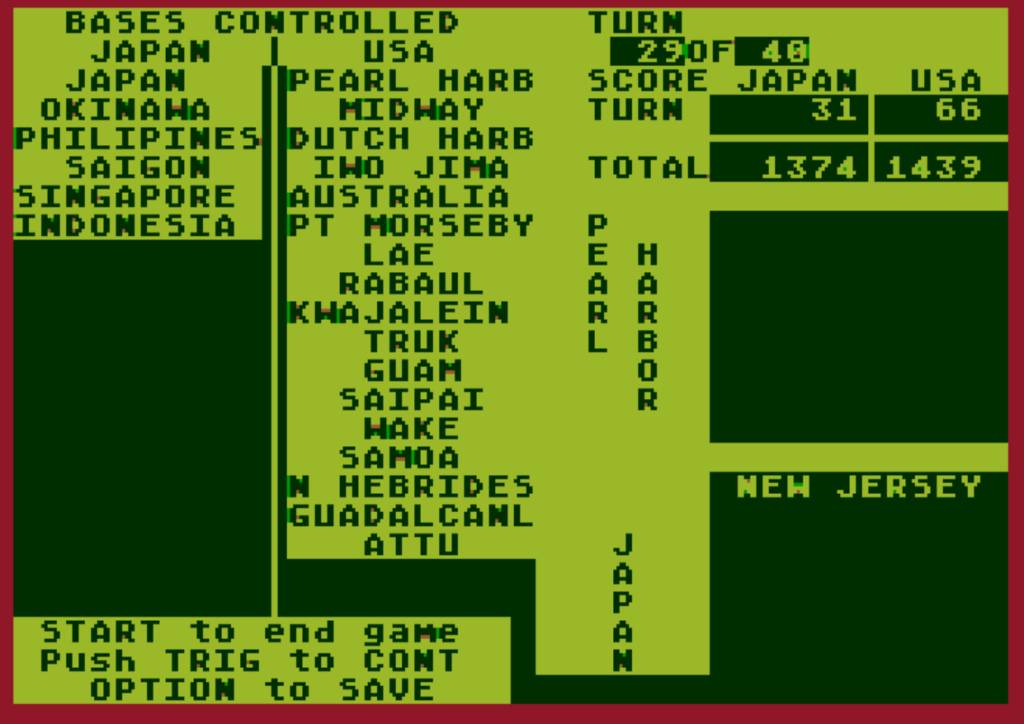
I still need to hold Japan for 10 turns to control it. This is made easier by a bug: a Japanese ship is created, and it “merges” with my fleet:
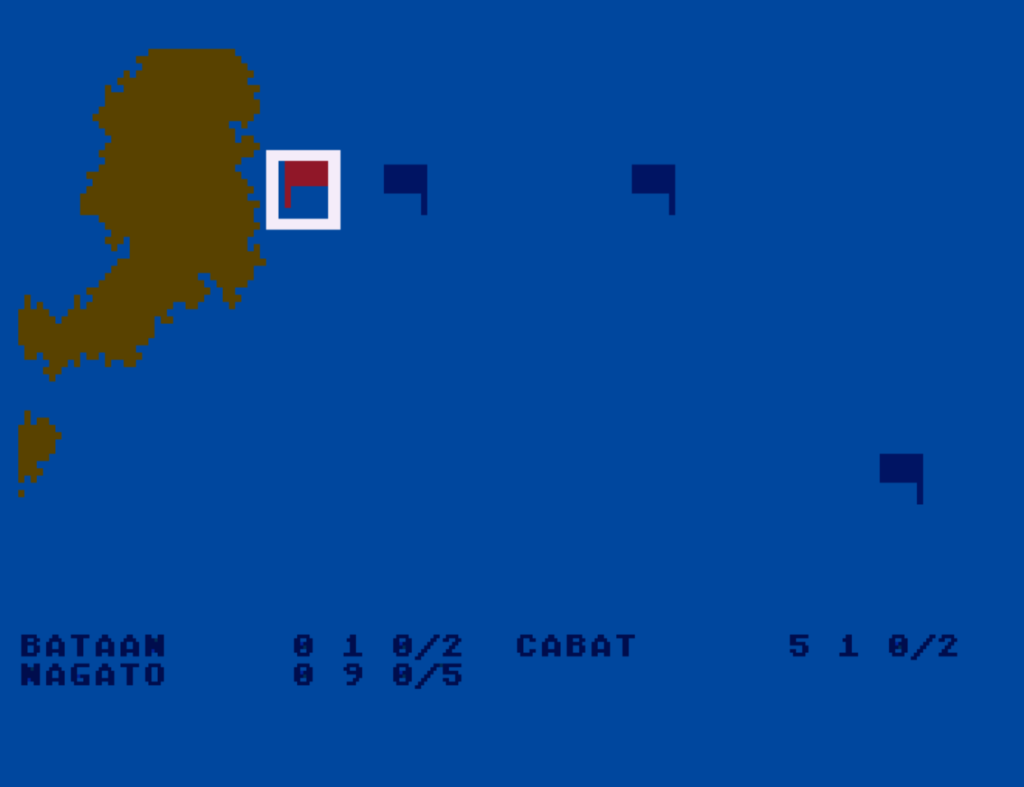
This “combined” fleet has a Japanese flag, but I can still control my ships individually and, critically, it still counts as besieging Japan. The mixed fleet is also immune to attacks. A few turns later the Japanese will produce a carrier that will join the mixed fleet and will be able to attack the other US fleets.
I take control of Japan on turn 38. The war carries on:
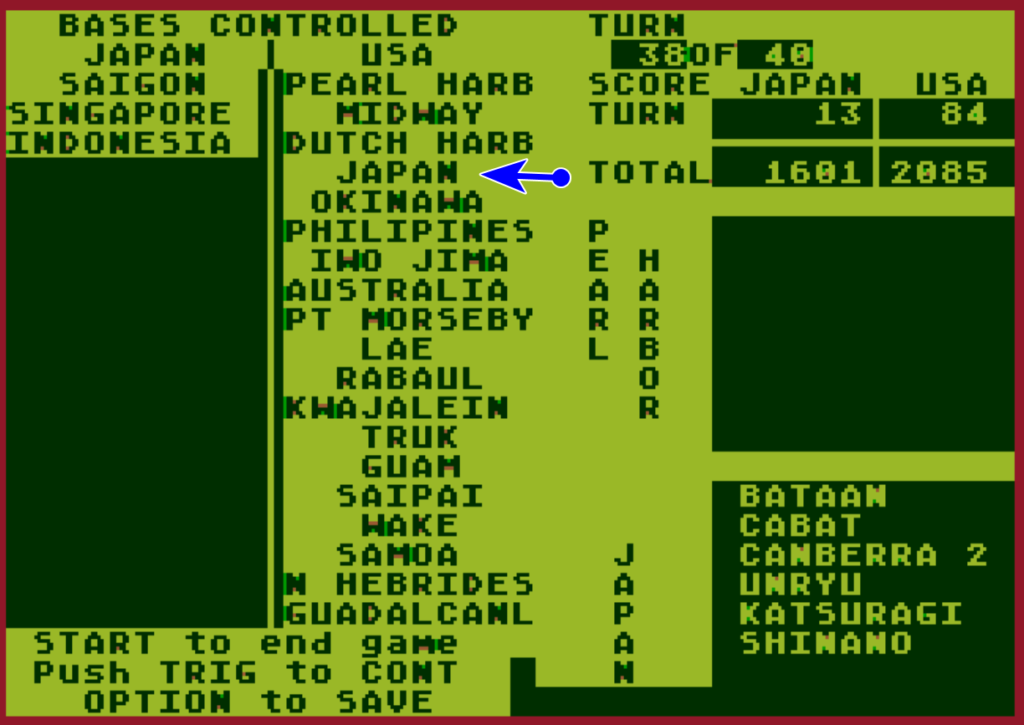
It finally ends turn 40 with a decisive American victory:
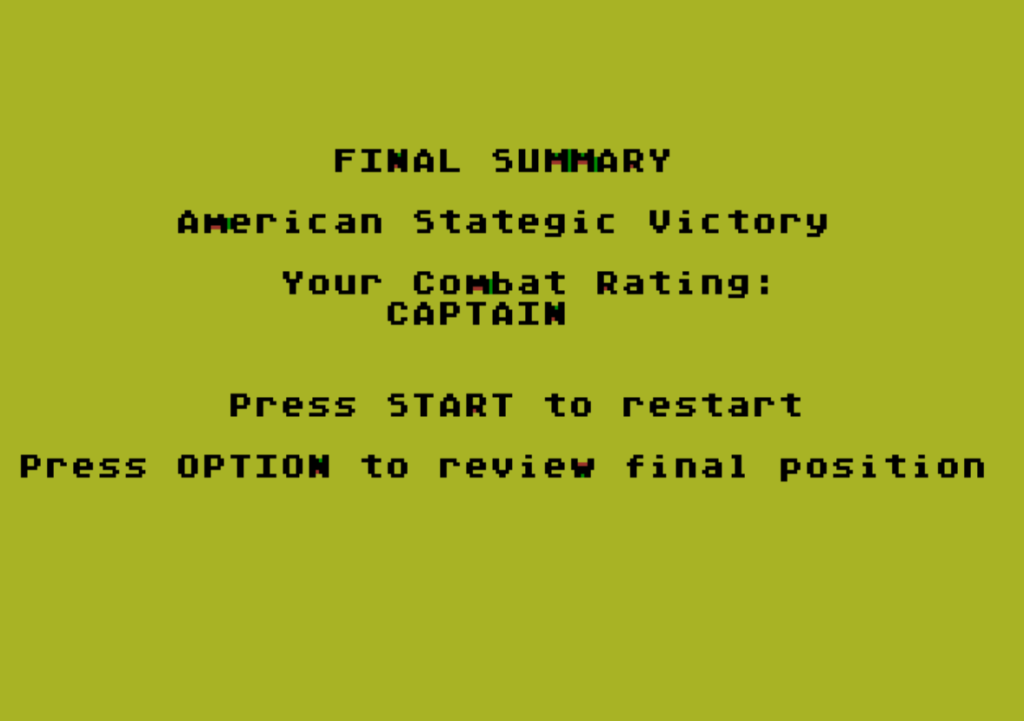
The first 5 or 6 turns were fun!
Ratings & Review
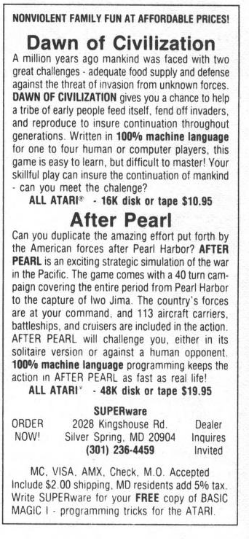
After Pearl, by George Schwenk, published by SuperWARE, USA
Genre: Naval Operations
First release: April 1984 on Atari
Average duration of a campaign: 1.5 hour
Total time played: 3 hours
Complexity: Easy (1/5)
Final Rating: Obsolete
Ranking at the time of review: 70/114
I don’t know much about the designer George Schwenk. He appeared suddenly in early 1982 as the designer of Avalon Hill’s Computer Football Strategy, the answer to SSI’s Computer Quarterback. The same year, he turned to Adventure International to publish a business simulation called Airline. I assume that he was unsatisfied with either the success of his games or his share of royalties because sometime in 1983 he answered a classified ad for a new company called Windcrest Software (“WANTED: State-of-the-art program publication. TYPES: Entertainment, education, graphics, applications, BBM, utilities. WE OFFER: Professional packaging, competitive royalties, advertising, marketing, distribution, timely publication, conversions to other systems“). He authored Windcrest’s only two games: Panzer War and Baseball’s Best. They must have been another disappointment, because despite the promise in the “WE OFFER” section I could only find one ad for the two games.
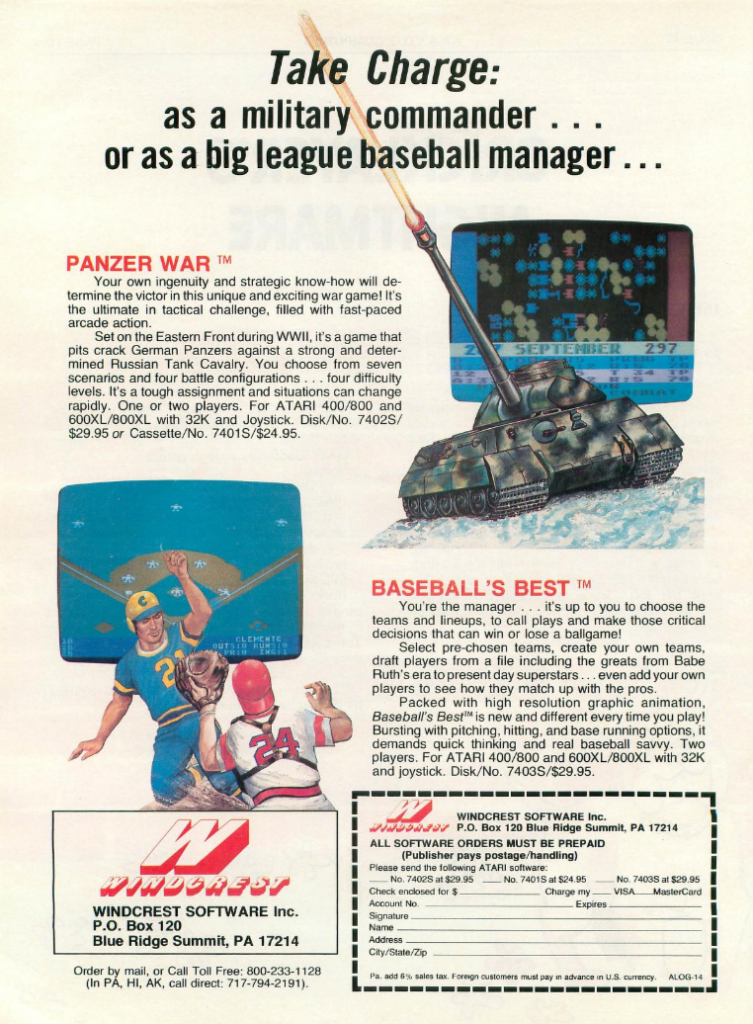
In late 1983, Schwenk was 31 and an experienced coder for the Atari. Presumably jaded by his earlier work-for-royalties, he created his own company: Superware (soon SUPERware) which initially sold XBASIC, an “upgrade to ATARI BASIC“:
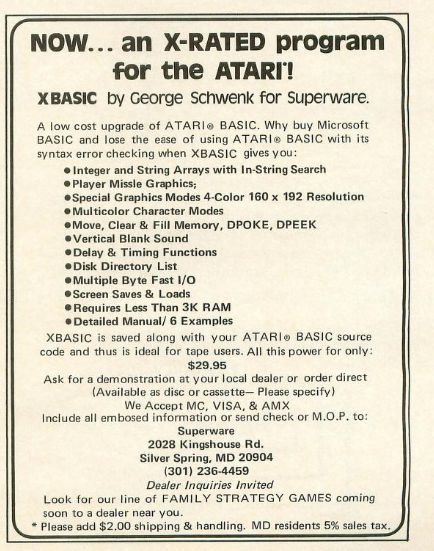
Also, sex sells.
Initially only targeting “serious” magazines, Schwenk must have spent before the end of 1983 more on advertisement than Windcrest ever did for his two games. However, this proved to be a successful strategy, XBASIC received favourable reviews, and Schwenk expanded his catalogue with more tools for coders wanting to code more efficiently (Scroll It, Chain It, Pack It, but also a tool called EASY that converted BASIC into machine language).
Meanwhile, Schwenk still coded games, but had learned his lesson: his next three games were published directly in SuperWARE.
- After Pearl, first mentioned in the April 1984 issue of Computer Gaming World,
- Dawn of Civilization, same date,
- Around the World, first mentioned in the October 1984 issue of Computer Gaming World,
Those were Schwenk’s final games, and SuperWARE seemed to have disappeared fully around 1985. Let’s rate the first of those games.
A. Immersion: Poor. I like big maps and I cannot lie, but the game is too unrealistic to be immersive.
B. UI, Clarify of rules and outcomes: Adequate. I was not able to find the manual and still quickly understood the game, so the game meets its target in terms of clarity of rules. Still, I wish there was a way to see on the map what is the range of airports and carriers, given how important these are to the game.
C. Systems: Poor. In an era when historic wargames tried to be simulationist, I find it refreshing and daring to propose a wargame covering the complete Pacific War that can be played in fewer than 2 hours. I feel its ruleset, where you only move ships and planes attack automatically, almost succeeds, but fails on details. The core issue is combat resolution, which is quite simply much too random when the game is about protecting a handful of key assets. This is aggravated by the fact that your carriers don’t protect one another, so when one of them loses her planes she is immediately sunk.
Less critically and possibly more subjectively, I also don’t like the idea of airbases becoming useless once depleted – I think the game would have been better if they could have been resupplied, for instance by keeping ships in their ports to keep with the “only-move-ships” logic. I think the game would also have been more strategic (and more realistic) with some fog-of-war.
The result is not great, but what kills the game comes in the next section.
D. Scenario design & balancing: Terrible. The game includes 3 scenarios, but the first one (“Yamato”) feels like a tutorial as you gang up on the famous battleship with 3 carriers, and the second one (“Midway”) is purely luck-based. This only leaves the main campaign I played.
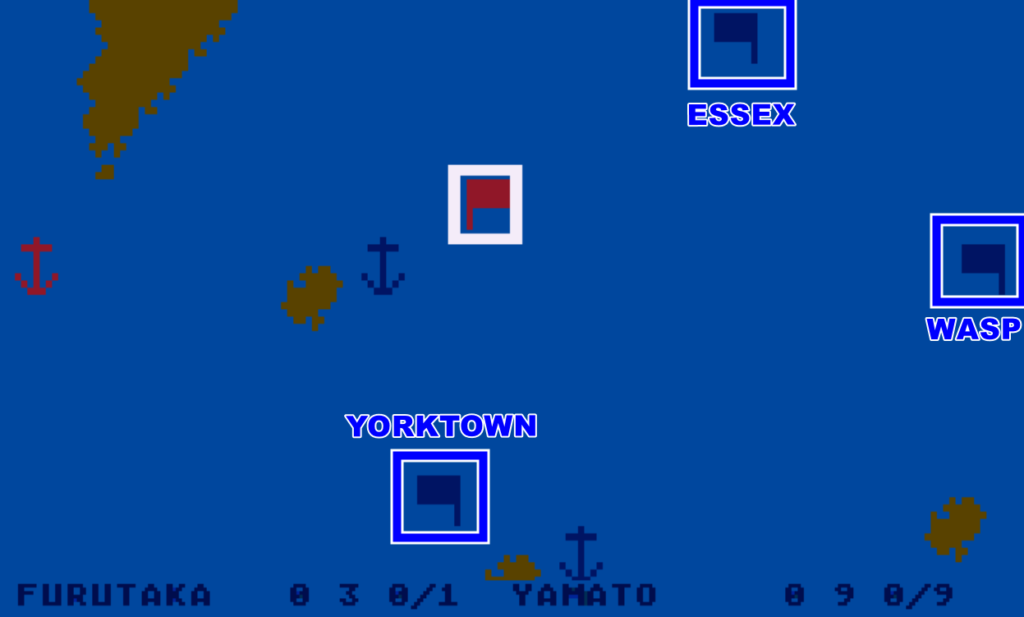
The AI behaviour is a mix of totally predictable (Japanese carriers beeline to their targets, so you know where to catch them) and totally stupid (attacking a garrisoned island without support). I played the full campaign twice in two different difficulty levels, and both times the AI lost all its ships before turn 12 and then kept its last batch of reinforcement in Japan – turning the game into a grind to take as many islands in as little time as possible.
E. Did I make interesting decisions? Barely. Initially, I believe I did, but I would have won the game no matter what.
F. Final rating: Obsolete. With a solid AI, it would have been a decent game. With a slightly better balancing on top of that – a great game. Alas, playing multiplayer could only fix the former issue.
Reception
All the reviews of After Pearl I could find reckoned that the game can be great fun… provided you were not a hardcore wargamer. Bob de Witt in the December 1984 issue of Computer Gaming World finds it “maddeningly restrictive“, but possibly appropriate for those “who are not dyed-in-the-wool wargamers, and who simply enjoy strategic planning and maneuvering without a lot of detail“, while the specifically-titled Washington Area Atari Computer Enthusiasts Journal warns that even if “Serious wargamers and historians will detest it with passion“, it was a nice and enjoyable game.
I was extremely surprised, on the other hand, by Evan Brocks’ reviews. The wargame specialist, who earlier on had panned Carrier Force for its lack of realism, gave After Pearl 3 stars and a half in his review of all wargames in 1987 (“recommended for the novice“), and then still gave it three stars in 1993: “it may well rot your mind, but this reviewer still likes it.” That’s quite an endorsement.
Now that I started with George Schwenk, I feel like I may as well cover his action-strategy game Panzer War and his gamified Conway’s game of Life Dawn of Civilization – both are unique in terms of design. I also tested Around the World for a bit: after creating a new character and buying my starting equipment, I got killed by a stray cat in downtown London – another unique experience. It is on the list of the cRPGAddict, so he may cover it soon.
3 Comments
“I don’t consider my personal “I can never sink the Zuikaku” curse broken because she is misspelt as the Zukaku in this game.”
Saved by the typo!
A fun read regardless!
Dawn of civilization sounds intriguing, I’m looking forward to that one.
I’m not sure which I enjoyed more… “blub-blub-blub,” or “Pearl Harbo(u)r.”
I can just imagine Schwenk debating with a friend: “I really need to convey the sheer awe of a carrier sinking through the medium of text. I’ve come up with ‘It is sinking. Blub-blub’, but I just feel it is not intense nough!”